Journalist Fionn Macarthur reports from the Moria refugee camp on the Greek island of Lesbos.
Following his first journey there in 2017, he recently returned to the island on a number of times to film a documentary.
He says that during his time there, he met inspiring people who constantly strive to maintain a sense of normality in an attempt to block out the reality of their dire situation.
My journey began on Instagram, scrolling through friends photos on nights outs, backpacking and interrailing.
These images are the standard ones you'll see from a lot of young Irish adults, aged 20-24, and while I’m sure to some it’s fun this type of wanderlust did not appeal to me.
I could not ignore some of the other images on Instagram - pictures of the refugee crisis in Europe and particularly in Greece. Seeing them left me feeling helpless, however I also felt a growing motivation into going there and helping.
I was intrigued from seeing others volunteering on the front lines on the shores of Europe. Could I be of help?
These were images of harsh rubber dingy boats too far over capacity, with some people wearing life jackets but most of them not. There were images of children without life jackets, and I would later find out these life jackets would soak water. Other life jackets were fakes and sold to refugees at a premium before their hellish journey.
I started searching online through NGOs and found that there were over 90 on Lesbos island, so many to choose from.
When searching specifically for NGOs working on the shore, I would find Refugee Rescue which was the only humanitarian and professional search and rescue organisation in the region which spot for boats crossing the Aegean Sea, using a seven-metre rib.
Not long after some initial contact, I booked my flight tickets and gave myself just one week before flying to the island. I was committed but quite anxious leading up to my time there, especially since this was the very first time I would travel overseas alone.
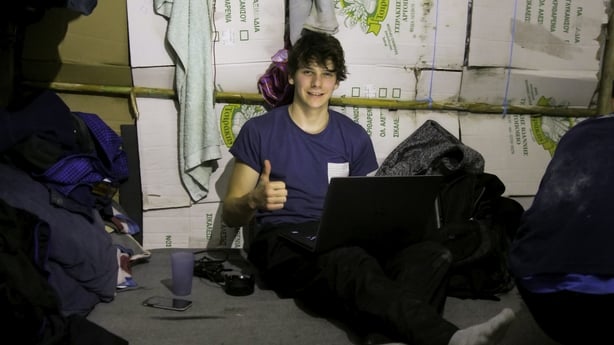
I boarded the plane from Dublin on 6 December 2017 and when I arrived at Lesvos, a beautiful sunrise lit up the sky and island below.
As the plane flew over before landing, I really could appreciate just how close the Greek island is to Turkey - only 5 nautical miles. It really puts it into perspective.
When I landed, I travelled by bus through the winding roads of the island stopping at every village along the way. I remember the images where refugees would walk along the roads, a distance of around 70km after arriving to the island by boat and despite the fear of criminalisation, people would often give refugees lifts.
After a few hours I arrived on the small Greek fishing village of Skala Sikamineas, which had 120 residents. There was a lovely quite harbour filled with traditional carvel built fishing boats and a white church built atop a rock with classic terracotta roof tiles. When I arrived, I spotted Refugee Rescue’s seven metre rescue boat moored up with the name 'Mo Chara’ ('My Friend' in Irish) printed along the bow.
"A lot of the refugees on board the bus were looking out through the windows at the sea, many with a disconsolate look"
During the two weeks I volunteered there, spotting for refugee boats crossing the treacherous waters of the Aegean Sea, I would spot from three main spotting locations with fellow volunteers.
There were night and day shifts in rotation. During the night shift you would spot half hour shifts in rotation between three people until midnight, and then each one hour shifts which could be eight hours altogether.
We would take turns looking through a night vision scope which was manufactured for hunting yet effective in locating boats filled with people as it showed heat signals.
It didn’t take long to discover the harsh brutalities that occur on these waters.
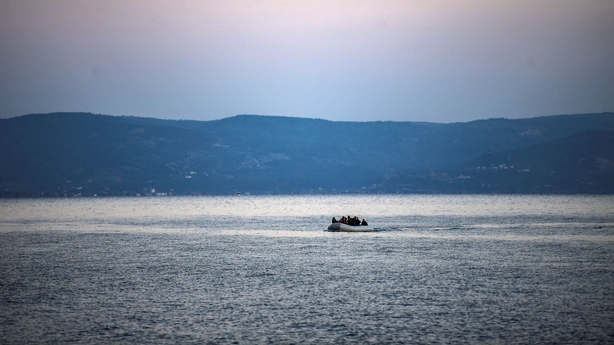
It was five nautical miles across to Turkey, yet only two and half nautical miles to the maritime border - I would often see the Turkish coast guard cross over the border.
We were all trained in which protocol to take once a refugee boat was spotted, this was in order to inform our field coordinators who would communicate with Greek coastguard and Frontex European Border Force. Then Refugee Rescue would head out onto the sea in ‘Mo Chara’ bringing the people on the rubber boats safely to the shore of Lesvos.
Shortly after that, they were taken by Greek police to Moria Refugee Camp which is 8km from the capital, Mytilene. They were then registered and given police papers.
After returning home from Lesvos on 19 December, I always had the urge to go back there again but this time as a filmmaker. My aim would be to create visuals and a feature length documentary, telling the stories from the refugees themselves living within Moria Refugee Camp. These would be stories from people who crossed the deadly Aegean Sea, fleeing war and persecution.
I returned to Lesvos on 24 May 2018, and again a handful of times over the course of two years.
When I landed this time around, I took the bus which went straight to the Moria camp. The journey would follow a road beside the shore where I could vividly see the coast of Turkey off in the distance again.
There was quite a lot of wind this particular day and the sea was noticeably rough, with windswept white horses sweeping across the water.
A lot of the refugees on board the bus were looking out through the windows at the sea, many with a disconsolate look. I couldn’t help but think they must be re-imagining the journey they themselves might have taken, one where they perhaps lost loved ones.
I later find out from speaking to a young man from Afghanistan that sometimes overloaded boats would become victim to rough seas, causing people to fall overboard or capsize. In just a matter of mere minutes, a child or adult could drown. He himself had lost his brother when crossing.
The bus pulled up beside Moria camp, where I saw a big white wall and endless rows of razor wire running along the wire fencing. The camp was originally a military base with a capacity to hold around 3,000 people.
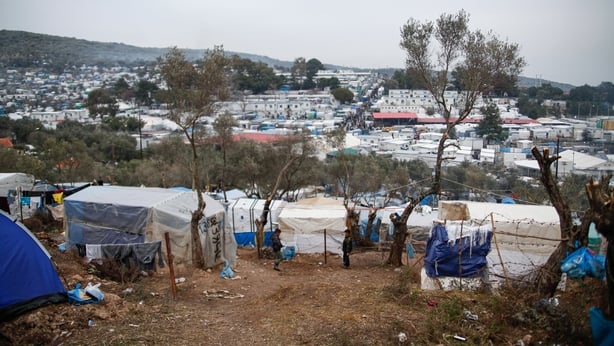
Today, Moria now holds over 22,000 people. I walk up the hill along the side of the camp toward the overspill, where I see people selling fruit and vegetables and some small electronics, batteries, lamps etc.
I soon reached the olive grove overspill which was what people who lived there refer to as ‘The Jungle’. This was a maze of tents and makeshift shelters stretch among the olive groves.
As I walked between alleys of tents, I ducked below clothes lines which were strung between every tent. There was water which ran down a gulley dug in the dirt, and when I looked up I saw a woman washing clothing in a plastic basin. Bags of rubbish pile up in places, bags which were not collected on time.
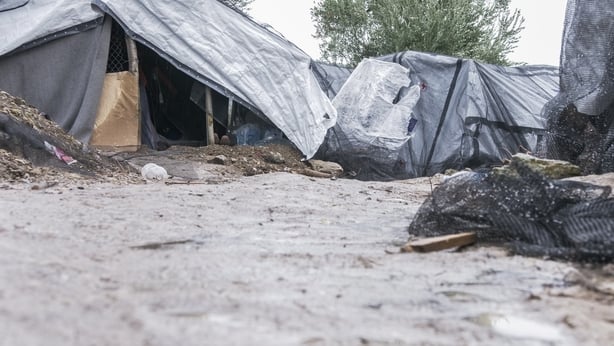
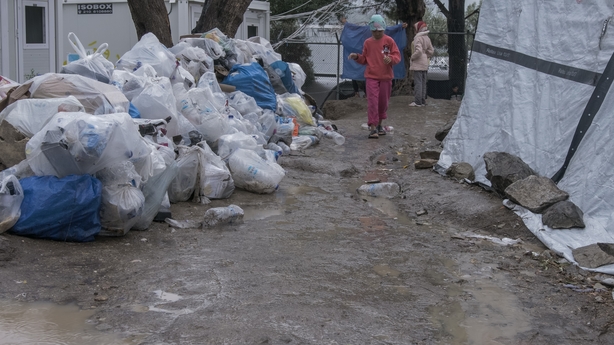
Over the course of about two weeks I would regularly walk throughout the 'Jungle' talking with people, and once they noticed I was not there for just a few days, they began to be more trusting.
I spoke with one man from Afghanistan who was constructing a shelter with three others. He told me people were living within these conditions for months and quite often over a year.
Shelters were made using reclaimed pallet wood and nails, waterproofed with canvas and using plastic bottle caps to prevent the canvas slipping off the nails. This was the first of many ingenious ways of innovation implemented here.
"People with nothing are so giving, inviting others into their temporary homes for tea and food"
Families were living within small summer tents in the height of winter, when temperatures dropped below freezing. Most rely on blankets and fires to keep the cold at bay.
Even people inside the camp who were fortunate to have electricity did not have it many times. The electricity went out for hours every day, sometimes even days, which led to people dying from hypothermia. This forced many to bring gallon metal oil containers with hot charcoals into their tent.
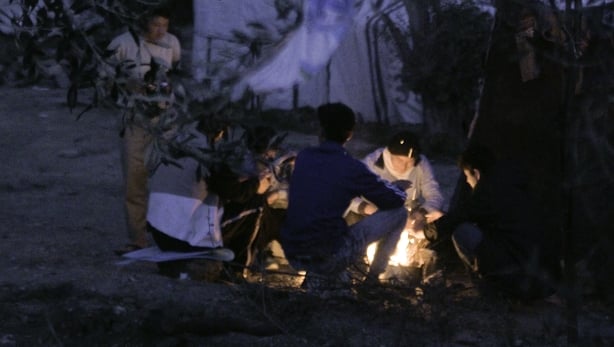
Two brothers who lived in a makeshift shelter with their elderly mother one night brought the fire inside. Early one morning one brother woke up and could not move his body and tried shouting for help but to no avail. After some time he GOT the strength to shout and the neighbours rushed in to drag them out. They told me they almost died to carbon monoxide poisoning. If the neighbours were not nearby, they would have definitely died.
These are risks they are forced to take and every day is uncertain - anything can happen. There was no safety and no security.
An Afghan woman told me that she and other women were scared living there. Every woman was scared, even women with husbands. One woman spoke of the fear of going to the toilet at night, as women were often sexually assaulted. There was also lots of shouting at night and fights occurred often.
As Moria continues to expand, it exposes women and young girls to greater risk. Women seeking safety in Greece find the exact opposite having to live within the conditions at Moria.
Women were supposed to be housed in special sections, however due to overcrowding this does not happen.
Refugees queue at the Greek asylum office in the hope of getting blue writing, marking their paper open which allows them to travel to mainland Greece. They then wait their decision for Greek ID. However many families and single men are getting deported, despite not having done anything wrong.
There is little to no change on the island. How many more people have to die? What has to happen for change? The conditions on Moria are dire - animals would not even live in them. Young children, babies, women and families are trapped in these inhumane conditions.
What amazes me the most is the hospitality of people within the camp.
People with nothing are so giving, inviting others into their temporary homes for tea and food. I've met people of so many different nationalities - Iraqi, Kurdish, Syrian, Yemeni, Somalian, Eritrean, Iranian and Afghan.
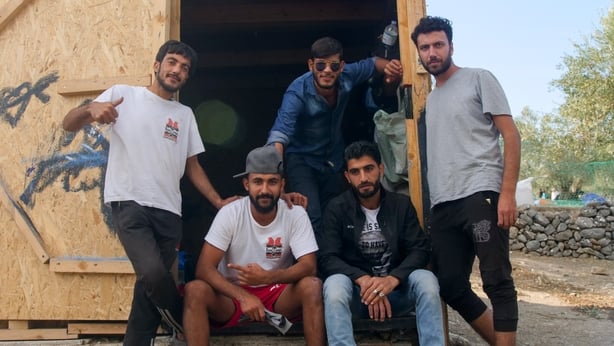
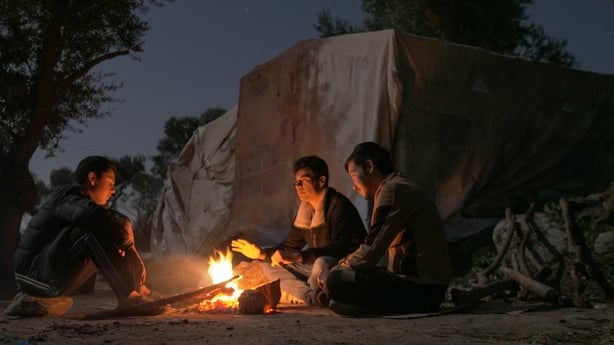
They sit around fires wrapped in blankets which keep them warm from the freezing nights. They entertain themselves by playing cards and listening to traditional music - the simplest of things. They laugh over endless cups of chai tea and it is like these that despite the dire situation and living conditions, all is forgotten about for a brief moment.
I have met the most resilient, empathetic people here. These are the memories that will stay with me forever.
It's easy to lose faith in humanity sitting in the confines of our homes watching, scrolling through the endless news feeds.
But the people I've met have escaped the most horrific situations, lost everything and still they remain hopeful. If that’s not inspiring I don’t know what is.

